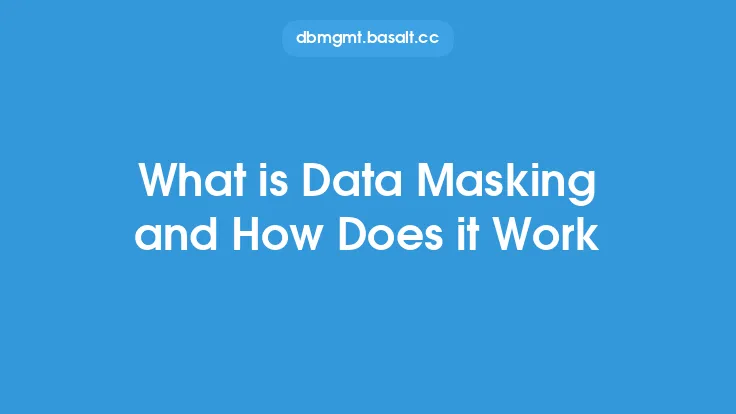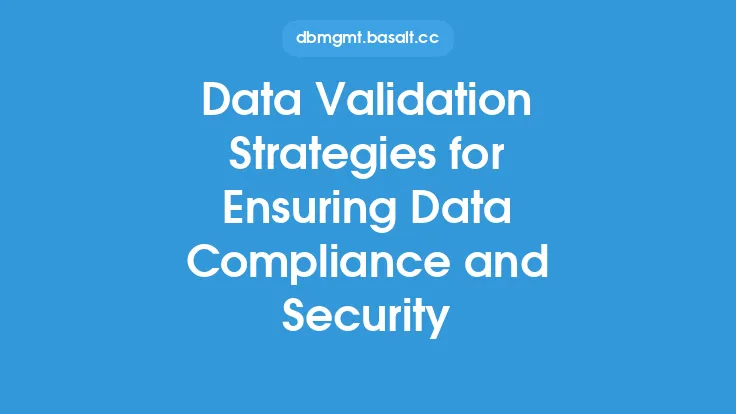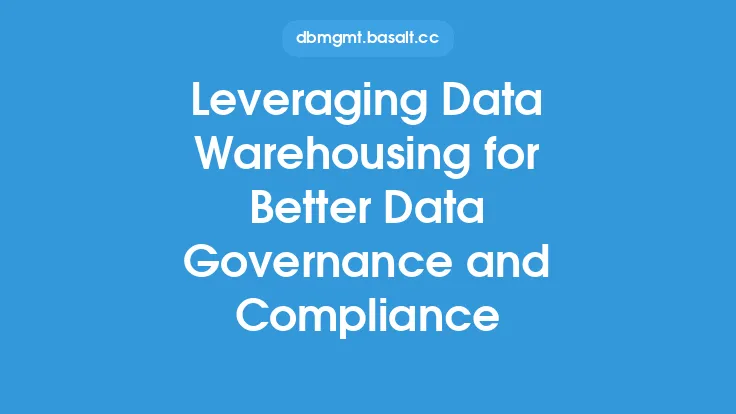In today's digital age, organizations are handling vast amounts of sensitive data, making data privacy and compliance a top priority. With the increasing number of data breaches and cyber-attacks, it's essential to protect sensitive information from unauthorized access. One effective way to achieve this is through data masking, a technique that conceals sensitive data by replacing it with fictional but realistic data. In this article, we'll delve into the world of data masking for compliance and data privacy, exploring its importance, applications, and technical aspects.
Introduction to Compliance and Data Privacy
Compliance and data privacy are critical concerns for organizations handling sensitive data. Various regulations, such as the General Data Protection Regulation (GDPR), Payment Card Industry Data Security Standard (PCI DSS), and Health Insurance Portability and Accountability Act (HIPAA), dictate how organizations must protect sensitive information. Non-compliance can result in severe penalties, reputational damage, and financial losses. Data masking plays a vital role in ensuring compliance by protecting sensitive data from unauthorized access, thereby reducing the risk of data breaches and cyber-attacks.
Data Masking Techniques for Compliance
Data masking techniques are designed to conceal sensitive data while maintaining its format and usability. There are several techniques used for data masking, including substitution, encryption, and tokenization. Substitution involves replacing sensitive data with fictional but realistic data, while encryption uses algorithms to scramble data, making it unreadable to unauthorized users. Tokenization replaces sensitive data with tokens or placeholders, which can be mapped back to the original data. These techniques can be applied to various data types, including personal identifiable information (PII), financial data, and healthcare data.
Application of Data Masking in Different Industries
Data masking has numerous applications across various industries, including finance, healthcare, and e-commerce. In the finance sector, data masking is used to protect sensitive financial information, such as credit card numbers and bank account details. In healthcare, data masking is used to protect patient data, including medical records and personal identifiable information. In e-commerce, data masking is used to protect customer data, including payment information and shipping addresses. By applying data masking techniques, organizations can ensure compliance with regulatory requirements and protect sensitive data from unauthorized access.
Technical Aspects of Data Masking
From a technical perspective, data masking involves several components, including data discovery, data classification, and data masking algorithms. Data discovery involves identifying sensitive data within an organization's database, while data classification involves categorizing data based on its sensitivity and importance. Data masking algorithms are used to apply data masking techniques, such as substitution, encryption, and tokenization. These algorithms can be implemented using various programming languages, including SQL, Java, and Python. Additionally, data masking can be integrated with other security measures, such as access control and auditing, to provide an additional layer of protection.
Data Masking and Cloud Computing
The increasing adoption of cloud computing has introduced new challenges for data masking. Cloud computing involves storing and processing data in a remote location, making it essential to ensure that sensitive data is protected from unauthorized access. Data masking can be applied to cloud-based data by using cloud-based data masking tools or by implementing data masking algorithms within cloud-based applications. Additionally, cloud service providers offer various data masking services, including data encryption and tokenization, to protect sensitive data. By applying data masking techniques in cloud computing, organizations can ensure compliance with regulatory requirements and protect sensitive data from unauthorized access.
Data Masking and Big Data
The increasing volume and variety of big data have introduced new challenges for data masking. Big data involves processing and analyzing large amounts of data from various sources, making it essential to ensure that sensitive data is protected from unauthorized access. Data masking can be applied to big data by using big data masking tools or by implementing data masking algorithms within big data analytics platforms. Additionally, big data masking involves applying data masking techniques to various data types, including structured and unstructured data. By applying data masking techniques to big data, organizations can ensure compliance with regulatory requirements and protect sensitive data from unauthorized access.
Conclusion
In conclusion, data masking is a critical component of compliance and data privacy, enabling organizations to protect sensitive data from unauthorized access. By applying data masking techniques, such as substitution, encryption, and tokenization, organizations can ensure compliance with regulatory requirements and reduce the risk of data breaches and cyber-attacks. As technology continues to evolve, data masking will play an increasingly important role in protecting sensitive data, particularly in cloud computing and big data environments. By understanding the importance and technical aspects of data masking, organizations can implement effective data masking strategies to protect sensitive data and maintain compliance with regulatory requirements.





